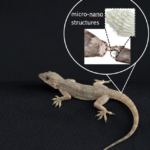News,Study finds how lizard tails are sturdy at regular times but detach easily when needed
A new study has found the tiny structures made up of mushroom-shaped micropillars topped with ultra-small pores allow lizards to quickly detach their tails when needed.
Microscopy images showed that each lizard tail muscle break-off point consists of highly dense mushroom-shaped micropillars with ultra-small nanopores dotting the top of each. These sections work like plugs into sockets, and the tail tends to break off these points – called fracture planes.
They found that the the tail’s structure consisting of deep crevasses between micropillars and other smaller potholes on their surfaces could slow the spread of an initial fracture on the tail.
Their new model suggests that these microstructures in the lizard tail allow for enhanced adhesion under tension, but when faced with a slight twist, the fracture plane cracks, and the tail can separate.
Learn about our two Decals!
 Click here to find out more about our Fall Bioinspired Design Decal and our Spring Bioinspired Design in Action Decal – ALL MAJORS are welcome.
Click here to find out more about our Fall Bioinspired Design Decal and our Spring Bioinspired Design in Action Decal – ALL MAJORS are welcome.Berkeley BioDesign Community
 Click here to learn about the BioD: Bio-Inspired Design @ Berkeley student organization or here to signup for more info.
Click here to learn about the BioD: Bio-Inspired Design @ Berkeley student organization or here to signup for more info.Search
Student Login





I imagine that the neurological circuits underlying these processes are governed by both 2d spacing maps with their brains as…
to reduce the impact of car accidents, it may be possible to study the force diverting physics of cockroaches to…
you see this type of head-bobbing stability in many avian creatures related to pigeons like chickens. the head ability to…
not like they taught horses how to run! this is an example of convergent evolution where both sea creatures and…
The brain functions in a similar way with neuronal connections. our brains are able to utilize the multiplicity of connections…